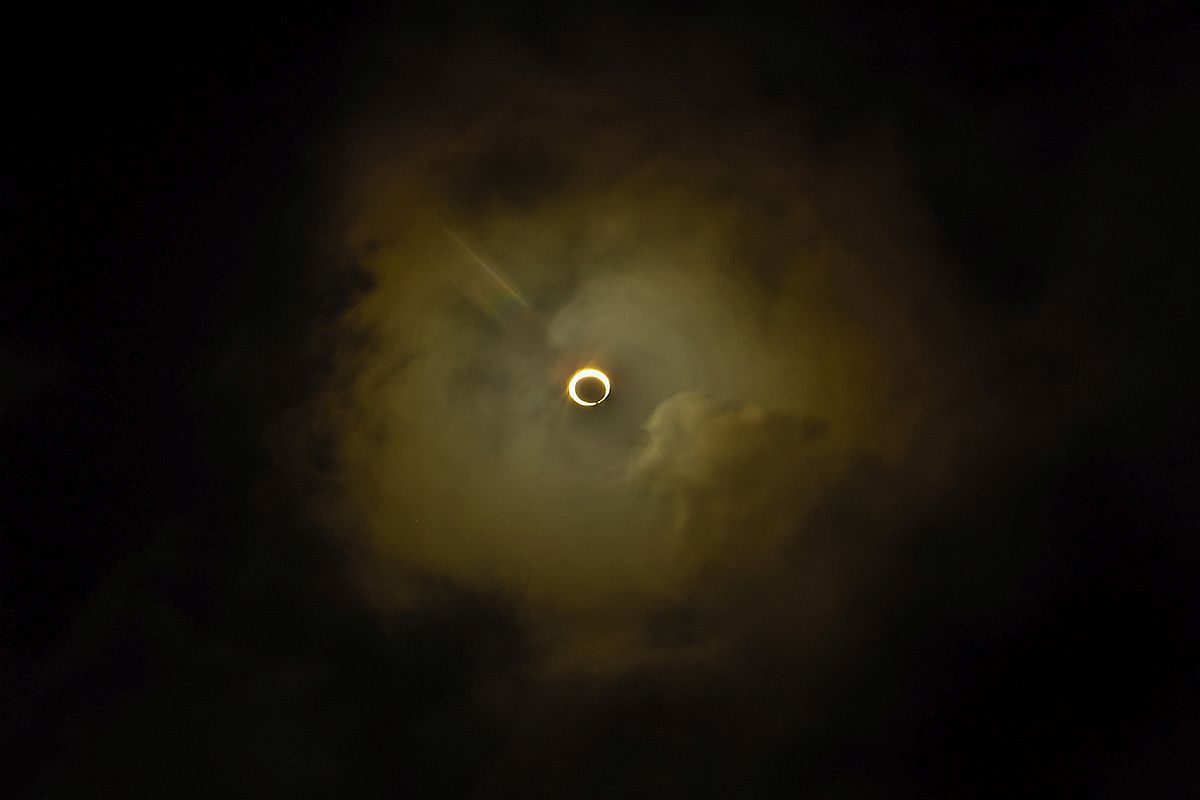1st solar eclipse of 2024 garners 1.2 mn posts on X: CEO Linda Yaccarino
The eclipse, which swept across 15 states in the US, Mexico, and Canada, began at 9.13 PM IST on Monday and continued till 2.22 AM IST on Tuesday.
The first solar eclipse of this year takes place on the summer solstice, which is the longest day in the Northern Hemisphere.

Annular Solar Eclipse. (Photo: iStock)
The annular solar eclipse, popularly known as ‘ring of fire eclipse’ will be visible this Sunday, Ministry of Science and Technology said.
The first solar eclipse of this year takes place on the summer solstice, which is the longest day in the Northern Hemisphere.
Advertisement
While people living along the path annular eclipse passing through Anupgarh, Suratgarh, Sirsa, Jakhal, Kurukshetra, Yamunanagar, Dehradun, Tapowan and Joshimath will be able to see the annular phase, people in rest of India can witness a partial eclipse, the ministry said.
Advertisement
When Moon comes between the Sun and Earth, the shadow falls on the surface of the Earth. The Sun is entirely covered by the Moon for a brief period. Those places that are engulfed by the dark, dense umbral shadow of the Moon experience the total solar eclipse.
In the regions that plunge into the soft diffused penumbral shadow of the Moon experience the partial eclipse. In all solar eclipse the Sun, Moon and Earth may not be perfectly aligned, and then we only have a partial eclipse. When the three celestial bodies happen to be in a straight line, we have Total solar eclipse.
“Annular solar eclipse is a particular case of the total solar eclipse. Like the total solar eclipse, the Moon is aligned with the Sun. However, on that day, the apparent size of the Moon happens to be a wee smaller than the Sun. Hence the Moon covers the central part of the Sun, and the rim of the Sun appear like a ‘ring of fire’ in the sky for a very brief moment” explains Samir Dhurde of The Inter-University Centre for Astronomy and Astrophysics, Pune.
Table 1
Sites where the annular eclipse will be seen.
Site Begins Max End duration
Dehra Dun 10:24 AM 12:05 PM 1:50 PM 14.0
Gharsana 10:12 AM 11:50 AM 1:36 PM 29.8
Kalanka 10:28 AM 12:10 PM 1:55 PM 28.0
Kurukshetra 10:21 AM 12:01 PM 1:47 PM 30.4
The Moon will cover about 99.5 % area of the Sun.
Table 2
Sites where partial eclipse will be seen
Site Begins Max End %cover
Agra 10:19 AM 12:02 PM 1:50 PM 90
Ahmedabad 10:03 AM 11:41 AM 1:32 PM 82
Amritsar 10:19 AM 11:57 AM 1:41 PM 94
Bengaluru 10:12 AM 11:47 AM 1:31 PM 47
Bhuj 09:58 AM 11:33 AM 1:23 PM 86
Chennai 10:22 AM 11:58 AM 1:41 PM 46
Dibrugarh 11:07 AM 12:54 PM 2:29 PM 89
Gawahati 10:57 AM 12:45 PM 2:24 PM 84
Hyderabad 10:14 AM 11:55 AM 1:44 PM 60
Indore 10:10 AM 11:51 AM 1:42 PM 78
Jaipur 10:14 AM 11:55 AM 1:44 PM 91
Japal 10:15 AM 11:56 AM 1:44 PM 59
Jodhpur 10:08 AM 11:47 AM 1:35 PM 91
Kandla 09:59 AM 11:35 AM 1:24 PM 85
K’kumari 10:17 AM 11:41 AM 1:15 PM 33
Kochi 10:10 AM 11:38 AM 1:17 PM 40
Kolkata 10:46 AM 12:35 PM 2:17 PM 72
Leh 10:29 AM 12:06 PM 1:47 PM 87
Lucknow 10:26 AM 12:11 PM 1:58 PM 88
Mt. Abu 10:05 AM 11:44 AM 1:34 PM 87
Mumbai 10:00 AM 11:37 AM 1:27 PM 70
Naini Tal 10:25 AM 12:08 PM 1:54 PM 96
Nanded 10:11 AM 11:53 AM 1:42 PM 66
New Delhi 10:19 AM 12:01 PM 1:48 PM 95
Port Blair 11:15 AM 12:53 PM 2:18 PM 39
Pune 10:02 AM 11:40 AM 1:30 PM 67
Rajkot 09:59 AM 11:35 AM 1:25 PM 82
Shilong 10:57 AM 12:46 PM 2:24 PM 83
Srinagar 10:23 AM 11:59 AM 1:40 PM 86
Trivandrum 10:14 AM 11:39 AM 1:15 PM 35
Udaipur 10:07 AM 11:47 AM 1:36 PM 86
(Source: PIB)
Do not use sunglasses, goggles, exposed x-ray sheet or lampblack over a glass. They are not safe, nor is viewing the Sun’s image on the surface of the water.
The welders’ glass number 13 or number 14 can be used to see the Sun directly with naked eyes.
Advertisement